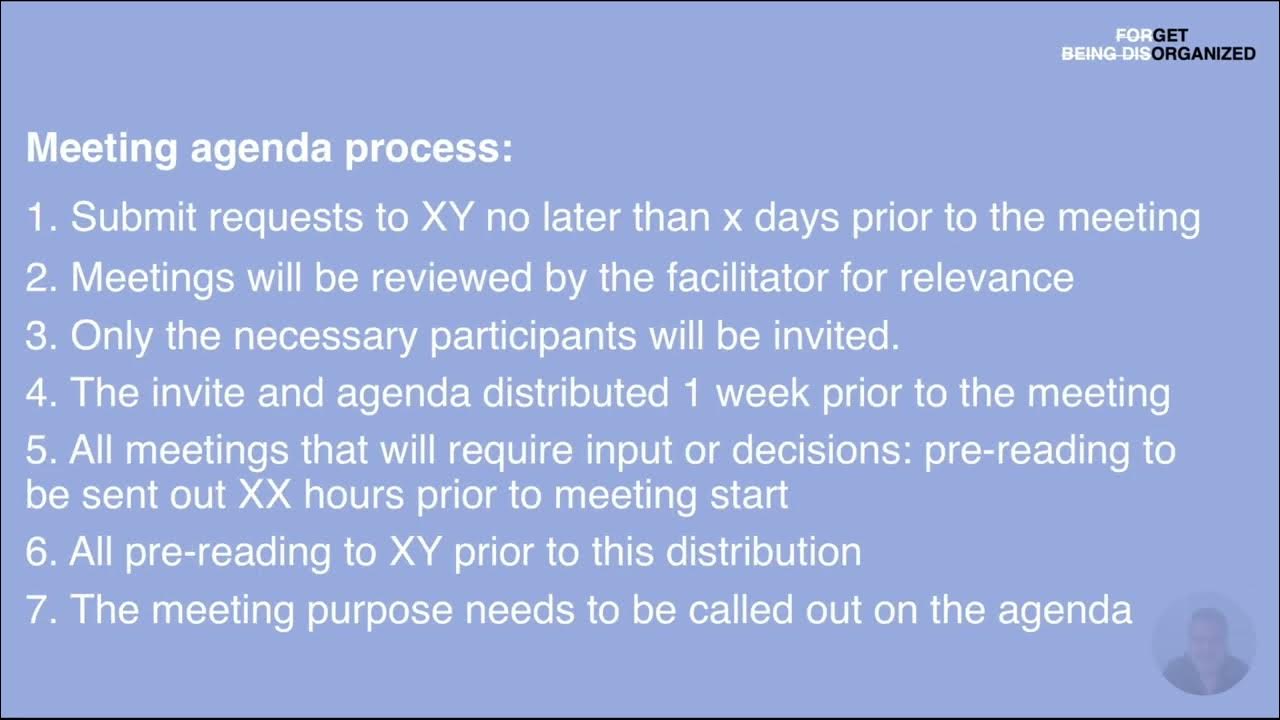How To Introduce Yourself To Client - How To Set Up Initial B2B Meeting
Summary
TLDRThis script emphasizes the importance of four key elements for conducting effective meetings: thorough preparation, understanding the other party's agenda, setting clear meeting goals and duration, and establishing oneself as an authority while maintaining respect and equality. It stresses the necessity of asking open-ended questions, listening to understand, and concluding with a clear plan for future communication to avoid prolonged sales cycles and ensure professionalism and perceived value.
Takeaways
- 🔍 Conduct thorough research on the individuals or company before the meeting to be well-prepared with relevant information.
- 🗓 Ensure the meeting has a clear agenda by asking the participants what they wish to discuss and incorporating this into your own plan.
- 🤝 Start the meeting by acknowledging the prospect's agenda to show respect and establish a collaborative tone.
- 📋 Prepare open-ended questions to guide the discussion and demonstrate your interest in understanding the prospect's needs.
- 🕒 Confirm the duration of the meeting at the outset to avoid time conflicts and ensure a focused conversation.
- 📉 Avoid ending the meeting without a clear plan for the next steps to prevent delays in the sales cycle.
- 👤 Establish yourself as an authority in your field without being overbearing, maintaining a respectful and equal relationship with the prospect.
- 🤔 Listen to understand rather than just waiting to speak, which shows value and professionalism in the conversation.
- 📝 Agree on a clear future action at the end of the meeting to streamline communication and avoid playing phone or email tag.
- 📈 Implementing these strategies can significantly reduce the sales cycle and enhance the prospect's perception of you as a true professional and expert.
- 🚀 By following these steps, you can expect positive outcomes in your meetings with prospects and customers, positioning yourself as a valuable resource.
Q & A
What are the four essential elements needed for an effective meeting according to the transcript?
-The four essential elements are preparation through research on the individuals or company, asking about the prospect's agenda at the start of the meeting, setting a clear plan and goal with open-ended questions, discussing the meeting's duration, and establishing authority while maintaining respect and equality.
Why is it important to research the individuals or company before a meeting?
-Researching helps you come to the meeting prepared with intelligent information, which allows for a more meaningful and value-adding conversation.
What should you do at the beginning of the meeting to ensure you understand the prospect's agenda?
-Start the meeting by asking if there is anything specific the prospect would like to discuss, incorporating their needs into your agenda.
Why is it crucial to have a clear plan and goal for the meeting?
-A clear plan and goal provide direction and clarity, ensuring the meeting is productive and the prospect sees value in the conversation.
How does discussing the meeting's duration at the beginning help avoid issues?
-Discussing the duration ensures both parties are aware of the time constraints and can adjust the conversation accordingly to avoid interruptions or incomplete discussions.
What is the significance of establishing yourself as an authority during the meeting?
-Establishing authority shows you are an expert in your field and capable of solving the prospect's problems, which builds trust and professionalism.
How can you maintain respect and equality while being an authority in the meeting?
-By being respectful of the prospect's time, not being overly deferential, and treating the conversation as a business discussion between equals.
Why is it important to agree on a clear future or next steps at the end of the meeting?
-Agreeing on next steps ensures continuity and progress in the relationship, avoiding confusion and the need for unnecessary follow-ups.
What can happen if you don't implement these four elements in your meetings?
-Without these elements, you may face issues such as lack of direction, prolonged sales cycles, and difficulty in reaching out to prospects or customers post-meeting.
How can implementing these elements improve the perception of you by prospects and customers?
-Implementing these elements can lead prospects and customers to see you as a true authority, a professional, and an expert, which can enhance the quality of your meetings and relationships.
What is the impact of ending a meeting without a clear future or next steps?
-Ending a meeting without a clear future can lead to increased sales cycles and inefficiencies, as it may require additional follow-ups and communications to establish the next steps.
Outlines

This section is available to paid users only. Please upgrade to access this part.
Upgrade NowMindmap

This section is available to paid users only. Please upgrade to access this part.
Upgrade NowKeywords

This section is available to paid users only. Please upgrade to access this part.
Upgrade NowHighlights

This section is available to paid users only. Please upgrade to access this part.
Upgrade NowTranscripts

This section is available to paid users only. Please upgrade to access this part.
Upgrade Now5.0 / 5 (0 votes)





